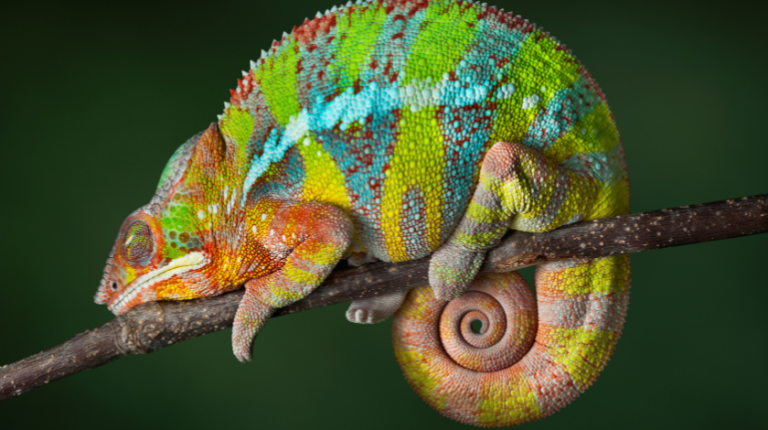Chameleons, known scientifically as Chamaeleonidae, are among the most fascinating reptiles in the world. Famous for their ability to change colors, chameleons have captivated humans for centuries with their unique biology and adaptive traits. Whether blending into their environment to avoid predators or using their long, sticky tongues to capture prey, chameleons are true survivors. In this article, we’ll dive deep into the world of chameleons, exploring their physiology, habitat, and the amazing characteristics that set them apart from other reptiles.
What Are Chameleons?
Table Of Contents
A Unique Family of Reptiles
Chameleons belong to the Chamaeleonidae family and are part of the larger order of lizards known as Squamata. There are over 200 different species of chameleons, most of which are found in Africa and Madagascar. However, they also inhabit parts of southern Europe, the Middle East, and Asia.
The Name “Chameleon”
The name “chameleon” comes from the Greek words chamai, meaning “on the ground,” and leon, meaning “lion.” This reference to a “ground lion” might stem from the chameleon’s hunting style, which is methodical and stealthy, much like a lion stalking its prey.
Amazing Color-Changing Ability
How Do Chameleons Change Color?
The chameleon’s ability to change color is often misunderstood. While many believe that chameleons change colors primarily to blend into their surroundings, it’s more about communication and regulation of body temperature. Specialized cells called chromatophores contain pigments, which expand or contract depending on external stimuli. These stimuli can be light, temperature, or even the chameleon’s mood.
Chameleons can shift between colors like green, yellow, brown, and even bright reds and blues, making them one of the most visually dynamic creatures on the planet.
Communication Through Color
Chameleons often use their color-changing ability to communicate with other chameleons. For example:
- Bright colors can indicate aggression or dominance, especially during territorial disputes or mating rituals.
- Darker colors might show submission or fear.
- Lighter shades help in controlling body temperature, reflecting sunlight to cool down.
Physical Traits of Chameleons
Eyes That See in All Directions
One of the most distinctive features of chameleons is their eyes. Unlike most reptiles, chameleons can move their eyes independently, giving them a 360-degree view of their environment. This trait helps them avoid predators and locate prey from a distance.
A Tongue Like a Missile
Chameleons possess incredibly long tongues that they can project at speeds of up to 60 miles per hour! The tongue, often longer than the chameleon’s body, is tipped with a sticky pad that helps them grab insects and other prey from a distance.
Zygodactylous Feet and Prehensile Tail
Another notable physical trait is their zygodactylous feet, where toes are fused together in groups, providing them with excellent grip for climbing. Their prehensile tails are also highly adapted for life in the trees, acting as a fifth limb that helps them balance and cling to branches.
Chameleon Habitat
Where Do Chameleons Live?
Chameleons are primarily arboreal, meaning they live in trees, although some species are ground-dwelling. They prefer environments such as rainforests, savannas, and scrublands. The island of Madagascar is home to the largest diversity of chameleon species, with several unique species that exist nowhere else on Earth.
Temperature and Climate Needs
As ectothermic (cold-blooded) animals, chameleons rely on their environment to regulate their body temperature. They are most commonly found in warm, tropical climates, but some species have adapted to more temperate regions.
Chameleons in Culture and Symbolism
Ancient Symbolism
Chameleons have long been symbolic creatures in various cultures. In ancient Africa, they were sometimes seen as creatures of mystery, change, and adaptability. Their color-shifting nature made them a symbol of transformation.
Modern Popularity
In modern times, chameleons are popular pets due to their fascinating behaviors and vibrant colors. However, caring for a chameleon requires specific knowledge about their diet, humidity, and temperature needs, making them better suited for experienced reptile owners.
Conservation Status
Threats to Chameleon Populations
While chameleons are adaptable, many species are now threatened due to habitat loss, deforestation, and the illegal pet trade. In particular, Madagascar’s chameleons are at risk as their natural habitat is destroyed for agriculture and development.
Efforts to Protect Chameleons
Conservation efforts are underway to protect chameleons, particularly in regions like Madagascar, where the most diversity exists. Some chameleon species are protected by law, and international efforts have been made to curb the illegal trade of these reptiles.
Chameleons as Pets
Is a Chameleon Right for You?
If you’re thinking about owning a chameleon as a pet, there are a few things to consider:
- Habitat requirements: Chameleons need specific temperature ranges, humidity levels, and access to live plants to thrive.
- Diet: They primarily eat live insects, so you’ll need to provide a variety of prey like crickets and mealworms.
- Handling: Chameleons are generally solitary and do not enjoy frequent handling. They can become stressed easily, so it’s important to handle them with care and only when necessary.
Popular Pet Chameleon Species
- Veiled Chameleon: Known for its vibrant green color, this species is commonly kept as a pet due to its adaptability.
- Panther Chameleon: This species is famous for its bright red, blue, and yellow colors, making it a favorite among reptile enthusiasts.
- Jackson’s Chameleon: With its distinctive three horns, the Jackson’s chameleon is another popular pet species, especially known for its calm demeanor.
Conclusion
Chameleons are incredible creatures, showcasing some of the most remarkable adaptations in the animal kingdom. From their vibrant color-changing abilities to their unique hunting techniques, these reptiles never fail to captivate. However, as humans continue to encroach on their natural habitats, it’s essential that we take steps to protect these fascinating animals for future generations to enjoy.
By understanding their needs and behaviors, both in the wild and in captivity, we can ensure that chameleons continue to thrive and inspire us with their unparalleled beauty and adaptability.
